Assignment on Anorexia Nervosa
56 Pages20000 Words108 Views
Added on 2021-02-20
Assignment on Anorexia Nervosa
Added on 2021-02-20
ShareRelated Documents
The treatment of AnorexiaNervosa in adolescents: Ametasynthesis of theparental perspective

Table of ContentsCHAPTER ONE..............................................................................................................................1INTRODUCTION...........................................................................................................................1CHAPTER TWO.............................................................................................................................4BACKGROUND.............................................................................................................................42.1 THE BURDEN OF ANOREXIA NERVOSA .....................................................................42.1.1 CLASSIFICATION AND DIAGNOSIS..................................................................42.1.2 EPIDEMIOLOGY....................................................................................................52.1.3 ANOREXIA NERVOSA CO-MORBIDITY...........................................................72.2 Treatment of Anorexia Nervosa.............................................................................................92.3 The role of parents in adolescents with chronic medical illness..........................................10Chapter 3: Methodology................................................................................................................103.1. Literature Search.................................................................................................................113.2. Rationale for Metasynthesis................................................................................................113.3. Study Design.......................................................................................................................133.4. Search strategy and selection Criteria.................................................................................153.5. Assessment of Article Quality............................................................................................16Chapter 4: Results .........................................................................................................................184.1 Data analysis............................................................................................................................184.2 Presentation of studies.............................................................................................................184.3 Quality assessment (Using CASP)...........................................................................................194.4 Thematic analysis.....................................................................................................................19Article 1: ...................................................................................................................................19Theme 1: Cause, Symptoms and Prevalence and Treatments of Anorexia Nervosa inAdolescents......................................................................................................................19Theme 2: Significance of treatment of Anorexia Nervosa in Adolescents.....................21Article 2.....................................................................................................................................22Theme 1 Diagnosis and impact of Anorexia Nervosa on Adolescents and family relations.........................................................................................................................................22Article 3: ...................................................................................................................................26

Theme 1: Family based therapy (FBT) treatment for Anorexia Nervosa .......................26Article 4.....................................................................................................................................30Theme 1 Roles of parents in management of Anorexia Nervosa....................................30Article 5.....................................................................................................................................31Theme 1: Challenges and limitations in FBT for treatment of adolescent patients ........31Chapter 5: Discussion....................................................................................................................34Chapter 6: Conclusion....................................................................................................................40Chapter 7: References....................................................................................................................45

CHAPTER ONEINTRODUCTIONEating disorders are severe mental health illnesses and rank highly among chronicillnesses in young people. They pose a significant public health burden involving hugecosts to the individual, the family and the society. Anorexia Nervosa is a severe eating disorder with its onset typically in adolescencemore commonly in females. Its severity poses a high economic and emotional burdenfor suffers and carers with challenges in treatment often leading to progression intoadulthood robbing a young person of years of productivity to themselves and thesociety, affecting their professional and educational development and possibly leadingto death. Individuals with AN have a significantly increased risk of co-morbid psychiatric disorderswith and increased risk of depression, obsessive compulsive disorders and pervasivedevelopmental disorders. AN is also listed as a chronic illness in adolescence withmajor impact on the adolescent growth, puberty and psychological development with amortality risk higher than other chronic diseases in adolescence like Type 1 diabetes orasthma. In addition, adolescents with other chronic illnesses like Type 1 diabetes, cysticfibrosis, celiac disease and irritable bowel disease have an increased risk of eatingdisorders2.Anorexia nervosa stands out as not only a severe mental illness but a severe chronicdisease which leaves lasting consequences on both the sufferer and their family withthe highest mortality rate of any psychiatric illness. The sufferers present with acute andchronic morbidities that affect every organ system of the body all increasing their risk ofmortality or long term risk of chronic health problems even when they have beensuccessfully treated and recovered from AN. Chronic underweight in adolescenceimpacts severely on growth and development with health effects in adulthood.Additionally, people with AN show a marked disturbance in cognitive and emotionalfunctioning. Of significant public health concern is also the fact that majority ofadolescents with an eating disorder do not seek or receive treatment for their weightproblems leading to more significant impact on their ability to function as adults.1
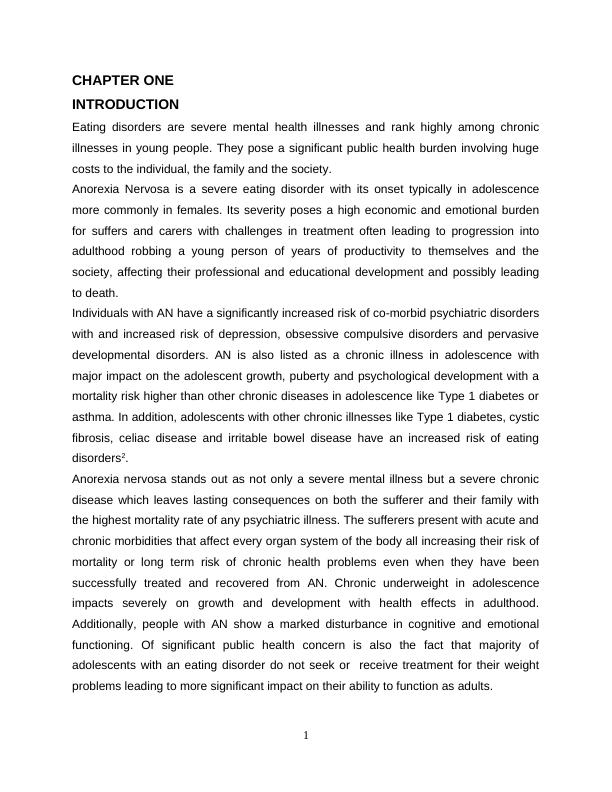
AN generally develops in adolescence when children are still very much in the care ofparents or guardians. The most studied interventions for AN focuses on the familieswhich largely depends on the support and commitment of parents to effect abehavioural change leading to a recovery of the young person. Parents play a great rolein the management of anorexia in terms of recognition, treatment and recovery. Theprocess generally begins from recognition of the problem by one or both parents whoare concerned about their child’s dieting behaviour or weight loss and therefore bringthem to the attention of health professionals.This study focuses on the qualitative studies on parents’ views about treatments foranorexia nervosa. Research has shown the superiority of family based therapy (FBT) inthe treatment of AN4 – a modality where parents and siblings play a central role in therecovery of the child. Although Quantitative studies on eating disorders helps us toevaluate outcomes of various treatment options, qualitative studies improves ourunderstanding giving us insight and a description of the complex issues involved in thetreatment from the perspective of the participants5. Qualitative research is intended topenetrate to the deeper significance that the subject of the research ascribes to thetopic being researched. It involves an interpretive, naturalistic approach to its subjectmatter and gives priority to what the data contribute to important research questions orexisting information6. This approach mimics that of a psychiatrist who in interacting witha patient lays emphasis on what the patient feels and experiences7. Evidence derivedfrom qualitative studies complements systematic reviews of quantitative studies6.Metasynthesis is a systematic review and integration of findings from qualitativestudies8. It combines and adapts approaches from both meta-ethnography andgrounded theory9 with a view to achieving analytical abstraction at a higher level, byrigorously examining overlap and elements in common among studies10. Thematicanalysis is interpretive and allows the identification of recurrent themes in identifiedstudies which can then be summarised under headings11. Qualitative syntheses provideevidence for the development, implementation, and evaluation of health interventions8.Qualitative studies have also been published on the views of parents/guardians,healthcare providers and patients on the treatment of AN. Metasynthesis on thetreatment of AN focusing on the experience of adolescent and adult patients have been2
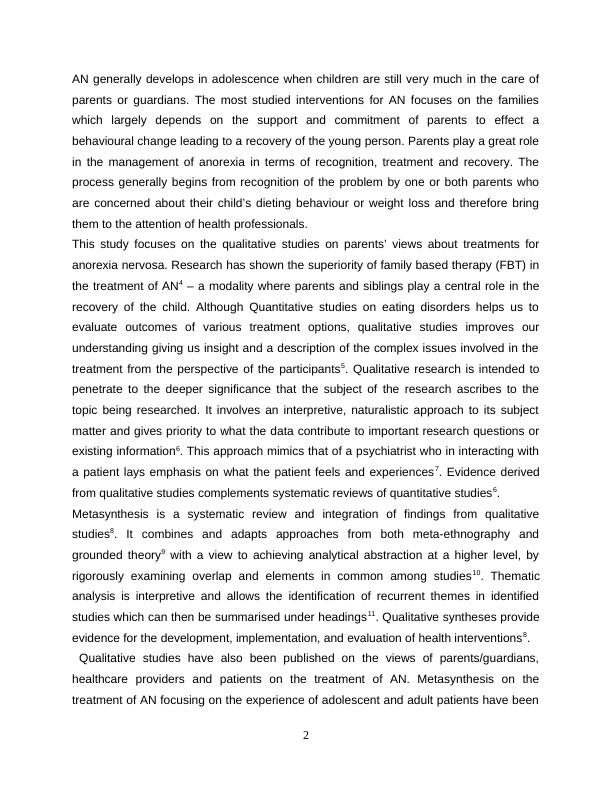
published outlining the importance of their family in their care. A metasynthesis has alsobeen published exploring the intersecting viewpoints of parents, families and healthcareprofessionals on the treatment of AN.Adolescence is a unique stage defined as a development period between childhood andattainment of adulthood. Parental involvement is extremely vital to the success ofinterventions in adolescents for chronic disease and important in the success ofanorexia nervosa treatment. In line with studies already done, my dissertation providesan update on previous metasynthesis focusing wholly on the views of parents about thetreatment of AN in their adolescents. My objective is to provide any new insight into theview of the parents as to what was optimal in providing the best outcomes and hopethat this will ultimately lead to the improvement of care for these young people.3
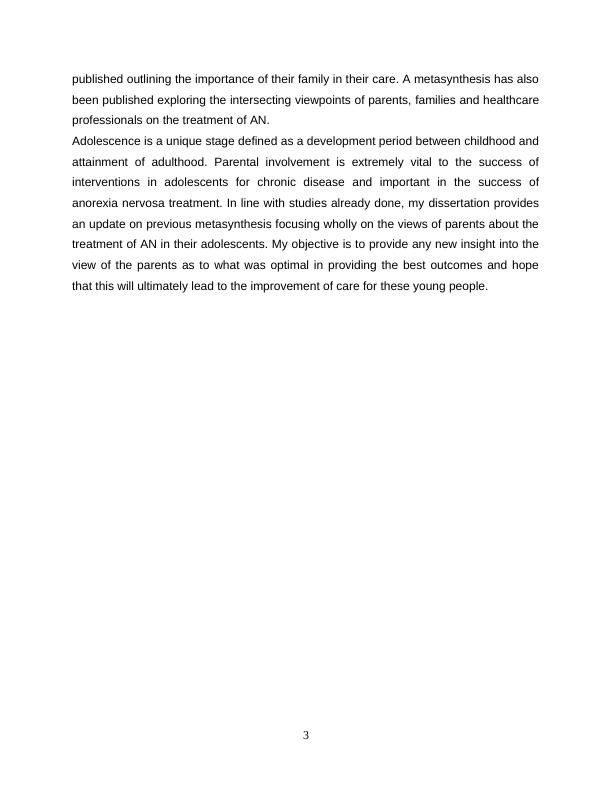
CHAPTER TWOBACKGROUND2.1 THE BURDEN OF ANOREXIA NERVOSA 2.1.1 CLASSIFICATION AND DIAGNOSISThe diagnostic criteria for Anorexia nervosa is set out by the DSM-V and ICD-11. It is aneating disorder characterised a significantly low body, an intense fear of weight gain orbecoming fat and a disturbance in the way an individual’s body weight and shape isexperienced or persistent lack of recognition of the seriousness of low body weight. Alow body weight is defined as a weight less than minimally expected for a child oradolescent in the DSM-V or more specifically in ICD-11 a BMI less than 18.5kg/m2 inadults or less than the fifth percentile for children and adolescents.DSM-V further classifies the severity of AN at four levels using the individual’s BMI:Extreme (BMI < 5kg/m2), severe (BMI 15-15.99kg/m2), moderate (BMI 16-16.99kg/m2)and mild (BMI17kg/m2)Amenorrhea previously listed in the DSM-IV is no longer required to make a diagnosisas this conflicts with the inclusion of males or pre-menarche females who may alsohave AN.AN is classified according to 2 subtypes – The restricting subtype which involves energyrestriction or weight loss by fasting, increased energy expenditure by excessiveexercising, and/or other non- purging compensatory behaviours; and thebinge–eating/purging subtype which includes the presence of binge eating and/orpurging behaviours like self-induced vomiting.Atypical AN is sets out in the DSM-V as a category where the individual does not fulfilall the diagnostic criteria for AN but still causes “clinically significant distress orimpairment”.A systematic review by Treasure et al aimed to provide evidence that AN follows adistinct course and a longitudinal trajectory with evidence that early interventions couldpossibly alter illness transition and prevent manifestation into adulthood. They describedan illness descent in three phases – the first marked by an ‘uneasiness and fullnessafter eating’ leading to reduction in food intake, the second marked by severe restriction4
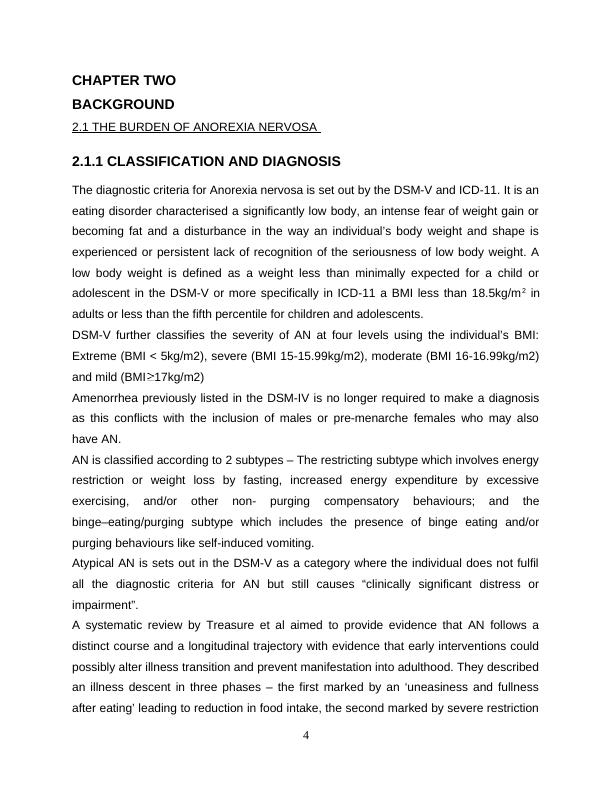
and increased activity levels and the third phase involving an extreme emancipation and‘general debility’. A later stage could commonly feature treatment resistance.2.1.2 EPIDEMIOLOGYAnorexia Nervosa typically emerges in early to mid-adolescence although it can beginat any age. AN affects 0.9-2.2% of women over their lifetime with a lower prevalence inmales of 0.3%. Incidence rates for anorexia nervosa are the highest for females in the15–19 age group constituting approximately 40% of all identified cases.The incidence rate is the number of new cases of a disorder in the population over aspecified period and is commonly expressed in terms of 100 000 persons per personyears for eating disorders. The study of incidence gives insight to aetiology. Prevalence can be expressed as point prevalence (prevalence at a specific point intime), one year prevalence rate (point prevalence plus annual incidence rate) andlifetime prevalence (proportion of people that had the disorder at any point in their life)and is useful for planning of heath care services as it shows demand.Various studies have been done in Europe estimating incidence and prevalence of ANinitially showing an increasing incidence but stabilising over the years although theseverity of cases requiring hospitalisation has increased since the 1970s’. Variation inthe results in these studies may be mostly due to different policies in different countriesand a variability of reporting systems, demographic difference in populations anddiagnostic criteria used for different regions at the time of individual studies. In a review carried out by Hoek and Hoeken the estimated incidence of anorexianervosa was 8 cases per 100,000 population per year for young females with aprevalence rate of 0.3%. These studies is this review however used varying ranges ofdiagnostic criteria to define AN.A UK primary care register based study representing about 5% of the population foundthat adolescent girls aged 15-19 years showed the highest incidence with a rate of47.5/100,000 for the year 2009; these rates remained stable between 200-2009although the incidence of atypical AN and other restrictive eating disorders increased inthat period. This study also showed that 24/100,000 girls had AN onset between 5-12years of age. In a cohort study by Keski-Rahkonen et al among Finish twin females the5
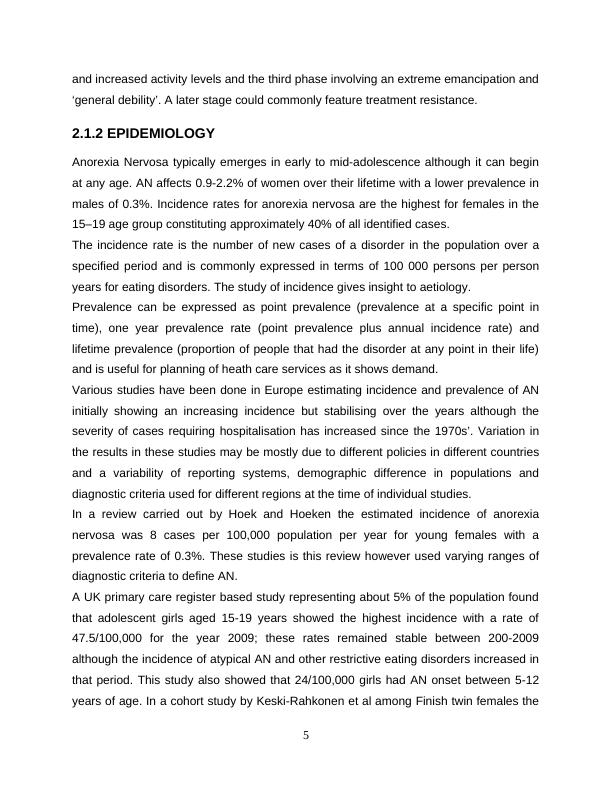
End of preview
Want to access all the pages? Upload your documents or become a member.
Related Documents
Adolescents Recover From Anorexia Nervosalg...
|11
|2351
|23
Eating Disorder: Causes, Symptoms, Diagnosis and Managementlg...
|12
|3635
|308
Management of Obesity and Eating Disorders in Adolescents and Childrenlg...
|15
|3587
|122
Effectiveness of Dialectical Behavioural Therapy for Anorexia Nervosa: Research Proposallg...
|12
|3167
|391
Impact of eating disorder Assignment PDFlg...
|4
|886
|257
Anorexic Body and Social Influenceslg...
|6
|1332
|173
